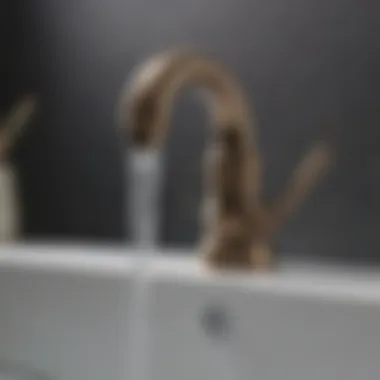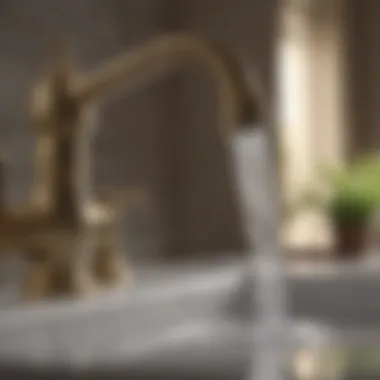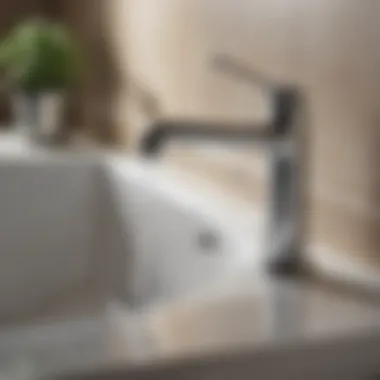Understanding Watersaver Faucet Aerators for Efficiency


Overview of Topic
Watersaver faucet aerators are becoming increasingly relevant in the home improvement industry. These fixtures are small devices fitted onto faucets to optimize water usage without sacrificing performance. By mixing air with the water flow, aerators can significantly reduce the volume of water used during daily tasks like washing hands or dishes. This is crucial in an era where water conservation is more than just a trend; it’s a necessity.
The importance of watersaver aerators cannot be overstated. High water bills, particularly in drought-prone areas, encourage homeowners and businesses to seek effective solutions. Aerators represent an accessible method to reduce water consumption by up to 50% or more, depending on the design and flow rate. Moreover, this minor, cost-effective addition promotes sustainable living, which aligns with modern environmental concerns.
Common Challenges and Solutions
Despite the numerous benefits, many homeowners face challenges when considering aerators. Some common issues include:
- Compatibility: Not all aerators fit every faucet type.
- Maintenance: Over time, aerators can become clogged with mineral deposits, affecting their performance.
- Water Pressure: Some users may be concerned about the potential impact on water pressure.
To overcome these challenges, consider the following solutions:
- Choosing the Right Aerator: Research your faucet’s specifications. Many manufacturers provide guidelines regarding compatibility.
- Regular Cleaning: Remove and clean aerators regularly to prevent buildup. Soaking in vinegar can effectively dissolve mineral deposits.
- Select Flow Rate: Opt for aerators with adjustable flow rates to balance water conservation with sufficient pressure.
Product Recommendations
Several brands lead the market in watersaver faucet aerators, ensuring quality and performance. Here are three noteworthy products:
- Niagara Conservation: Known for their efficiency, Niagara aerators can save a significant amount of water without compromising pressure.
- Moen: Offers versatile and aesthetic designs that provide water savings alongside added style to your kitchen or bathroom.
- Hansgrohe: Provides high-quality aerators that combine water-saving technology with sleek design.
Each product presents distinct benefits such as easy installation, varying flow rates, and durability, making them ideal choices for water-conscious homeowners.
Step-by-Step Guides
Implementing watersaver aerators is straightforward, even for those with limited DIY experience. Here’s a practical guide:
- Gather Necessary Tools: You will need an adjustable wrench and a small towel.
- Turn Off Water Supply: Ensure the water supply to the faucet is turned off to prevent leaks.
- Remove Existing Aerator: Use the wrench to carefully unscrew the existing aerator from the end of the faucet.
- Install New Aerator: Align the threads of the new aerator with those on the faucet and hand-tighten. For added security, use the wrench but avoid overtightening.
- Test the Water Flow: Turn on the water supply and check for leaks. Adjustments may be necessary if leaks occur.
Proper installation can enhance your faucet’s efficiency and contribute significantly towards water conservation efforts.
"Watersaver faucet aerators are a simple yet effective solution for water conservation at home, showcasing how small changes can lead to substantial benefits."
By understanding the function and advantages of watersaver faucet aerators, along with definitive steps for installation, homeowners can enjoy both improved efficiency and eco-friendly living.
Understanding Faucet Aerators
Faucet aerators are small devices attached to the end of faucets. They play a crucial role in both residential and commercial settings. Understanding their design and function allows users to appreciate their impact on water usage, efficiency, and conservation. This section will provide insights into what aerators are, the different types available, and their specific benefits.
Definition and Function
A faucet aerator is a device that blends air with water flow from a faucet. It is engineered to reduce water usage while maintaining adequate pressure. This reduction leads to significant water savings without impacting the user experience. Essentially, aerators help to create a steadier flow rate while using less water, making them a valuable addition to any kitchen or bathroom.
By decreasing the amount of water flowing from the faucet, aerators contribute to lowering water bills as well as minimizing environmental impact. They can effectively make every drop count, which is especially vital in areas facing water scarcity.
Types of Aerators
Understanding the different types of aerators can aid in selecting the most suitable option for specific needs. There are three main types of faucet aerators:
Regular Aerators
Regular aerators are the most common type. They typically create a gentle stream of water by mixing it with air. This mix helps to reduce water usage while still providing a satisfying flow. One key characteristic of regular aerators is their ability to function well under a variety of water pressure conditions.
Their popularity stems from their simplicity and effectiveness. Regular aerators offer a wide range of flow rates, usually between 1.0 to 2.2 gallons per minute, making them adaptable to different home settings. However, one disadvantage is that they can occasionally become clogged with sediment and may require cleaning or replacement.
Laminar Flow Aerators
Laminar flow aerators function by directing a smooth, non-aerated water flow. This type allows for a clean stream, resulting in less splashing and offering a more controlled use of water. A significant feature of laminar aerators is that they reduce turbulence in the stream, thus ensuring a precise flow.
They are often favored in settings where precision is important, such as when filling bottles or rinsing delicate items. Their downside, however, is that they may require higher water pressure to perform effectively. This could limit their use in areas with low residential water pressure.
Self-cleaning Aerators
Self-cleaning aerators are designed with innovative features that prevent sediment build-up. This characteristic makes them particularly appealing for households in regions with hard water or significant mineral content.
These aerators often have mechanisms that dislodge debris automatically, maintaining optimal flow rates without user intervention. They contribute to longevity and lower maintenance needs. However, this advanced design may come at a higher initial cost compared to standard aerators, which could be a consideration for budget-focused users.
The Importance of Water Conservation
Water is a basic necessity for life, but its availability is not guaranteed. This article emphasizes the need for water conservation as a fundamental practice. The ongoing global water crisis, coupled with local challenges, makes it vital for individuals and communities to adopt sustainable water use habits. Watersaver faucet aerators are important tools in this endeavor. They help to reduce water consumption while maintaining functionality.
Conserving water can lead to significant benefits. It not only helps in conserving resources but also lowers water bills for households. It is also essential for maintaining the health of ecosystems. Furthermore, effective water conservation can reduce the strain on local infrastructure; over time, this can translate into a healthier environment and improved economic stability.


Global Water Scarcity Issues
The world is facing a critical water scarcity crisis. According to the United Nations, nearly 2 billion people live in countries experiencing water stress. As population grows, the demand for freshwater increases. Industrialization and climate change exacerbate this problem, leading to uneven water distribution.
A combination of factors contributes to global water scarcity, such as:
- Climate change leading to altered weather patterns.
- Increased agricultural demands for irrigation.
- Urbanization which raises water consumption levels.
- Pollution that contaminates existing water sources.
Each of these elements underscores the need for sustainable practices. Water scarcity affects not only individual lives but also socio-economic stability and global peace.
Local Water Supply Challenges
Water supply challenges are not just a global problem; they are local as well. Many regions face unique challenges that threaten their access to clean water. Droughts can lead to severe limitations on water use. In some places, aged infrastructure leaks can waste significant amounts of water. These issues necessitate urgent action at the local level.
Here are some common local challenges:
- Aging infrastructure that requires improvements.
- Contamination of local water sources with chemicals and waste.
- Seasonal variations that impact water availability.
Residents can benefit from implementing water-saving technologies. Watersaver faucet aerators offer an effective way to address both local and global hydration challenges.
"Saving water is a simple practice that can yield tremendous benefits for all of us."
Advantages of Watersaver Faucet Aerators
Watersaver faucet aerators provide a range of advantages that contribute to both environmental benefits and improved economic efficiency. Their role in water conservation is undoubtably vital, especially as global attention turns toward sustainable practices. Residential and commercial settings alike can greatly benefit from these devices. They optimize water usage while maintaining the quality and efficiency of water flow. The advantages discussed here focus on reduced water usage, economic benefits, and enhanced user experience.
Reduction in Water Usage
One of the most significant advantages of watersaver faucet aerators is the marked reduction in water usage. By mixing air with water, these aerators create a steady stream that requires less water to achieve the same level of satisfaction during use. This is especially important in households with high water consumption activities like washing dishes or showering.
The typical aerator can halve the flow rate from the standard 2.2 gallons per minute to about 1.5 gallons per minute or even lower. This reduction promotes conservation without sacrificing performance. Choosing watersaver aerators allows a household or business to use less water, contributing to broader environmental goals of reducing waste and conserving resources.
Economic Benefits
The economic advantages offered by watersaver faucet aerators cannot be overlooked. They represent a cost-effective solution for managing water expenses, making them a wise investment for both homeowners and property managers.
Lower Water Bills
Focusing on lower water bills, this aspect clearly stands out as a vital benefit. With the efficiency of watersaver aerators, it is common for users to observe a reduction in their monthly water bills. This can lead to considerable savings over time. Homeowners often notice a difference within just one billing cycle, reinforcing the immediate financial advantage of switching to these aerators.
The key characteristic that sets apart lower water bills is the direct link between reduced water flow and utility cost. Instead of wasting money on high water usage, residents can better allocate their budgets. A unique feature here is the tiered pricing models many municipalities use for water consumption. As users reduce their water usage, they not only lower their bills but may also drop into lower pricing tiers, amplifying their savings.
However, it is important to note that the actual savings depend on individual usage patterns. In some cases, the savings might be minimal if a household is already conserving water. Nevertheless, adopting watersaver aerators typically leads to a positive change in bill analysis.
Cost-effectiveness in Installation
Another notable economic benefit is the cost-effectiveness in installation. Installing watersaver faucet aerators is relatively simple and can usually be done without professional assistance. Most homeowners can complete the process with basic tools found around the house. This means that the investment for installation remains low, which adds to the overall appeal of integrating these devices into any existing plumbing systems.
The key characteristic that defines the cost-effectiveness is the minimal labor and expertise required for installation. In most cases, it involves unscrewing the old aerator from the faucet and replacing it with a new one. This direct approach eliminates the need for costly plumbing services.
A unique feature of this cost-effective installation is that aerators can often be removed and replaced easily. This allows for quick upgrades and maintenance as needed, further bolstering their attractiveness. While there may be an upfront cost for the aerators themselves, the combination of savings on installation and monthly bills makes them a beneficial choice.
Enhanced User Experience
Beyond economic and environmental advantages, watersaver faucet aerators also improve user experience. The innovation allows for consistent water flow while using significantly less water. Users can notice the smooth flow and maintain comfort in daily activities such as handwashing and dishwashing. Various models are designed to cater to specific preferences, which reinforces their suitability for diverse settings.
The smart design that facilitates ease of use, combined with the emphasis on water efficiency, makes these devices popular among homeowners. As people become more aware of their resource consumption, using watersaver aerators aligns their habits with their values. By embracing these innovations, users can feel both responsible and satisfied.
Mechanics of Watersaver Faucet Aerators
Understanding the mechanics of watersaver faucet aerators is essential for grasping their role in improving water efficiency. By effectively combining a series of physical principles, aerators can significantly reduce water consumption without sacrificing performance. This section explores how these devices operate and the specifications that affect their flow rates.
How Aerators Work
Faucet aerators function by blending air with the water flow. The core mechanism involves a screen or a series of inserts that disrupt the water stream, creating tiny droplets and increasing aeration. As water passes through the aerator, it enters a chamber that causes a mix of air and water. This process results in a reduction in the overall water volume used while maintaining a strong and steady flow.
The design of an aerator often includes several key components:
- Mesh Screens: Prevents debris from entering the flow and helps in mixing air effectively.
- Flow Restrictors: Limits the volume of water, ensuring that only a specified amount is dispensed.
- Pressure Regulation: Maintains consistent water pressure for an optimal user experience.
A crucial aspect of aerators is their ability to provide a satisfying user experience despite lower water usage. This is achieved by maintaining the sensation of high flow, which is important for many household activities, such as washing hands or cleaning dishes.
Flow Rate Specifications


Flow rate specifications are vital to understanding how much water a faucet aerator can efficiently deliver. Typically, aerators are rated based on their output in gallons per minute (GPM). Most watersaver aerators limit flow rates to 1.5 GPM or less, aligning with water conservation goals without compromising usability.
When considering flow rates, a few factors should be kept in mind:
- Local Water Supply Regulations: Many areas have laws that dictate maximum flow rates for faucets and fixtures.
- User Needs: Consider what daily tasks require water. Some might prioritize higher flow rates for kitchen tasks while accepting lower rates for bathroom sinks.
- Installation Location: Aerators work differently based on where they are installed. For instance, kitchen faucets may require a different specification compared to bathroom sinks.
"Choosing an aerator with the proper flow rate can balance water conservation and user satisfaction effectively."
In the end, selecting the appropriate aerator requires careful consideration of flow rates and intended use. With the right knowledge, users can enjoy an efficient system that meets their specific needs.
Installation of Watersaver Faucet Aerators
The installation of Watersaver faucet aerators is pivotal in this discussion. Installing these devices allows households and businesses to optimize their water usage, which directly contributes to water conservation efforts. Additionally, this process is not just about attaching a product; it encompasses understanding the tools needed, following a methodical installation approach, and knowing how to maintain the aerator for prolonged efficiency.
Installing a faucet aerator offers various benefits. For one, reducing water flow without sacrificing performance leads to substantial savings on water bills. Furthermore, many individuals want to participate in eco-friendly practices. By incorporating these aerators, users play a role in environmental sustainability. Therefore, understanding how to properly install these fixtures is essential for effective water management.
Tools Required for Installation
Before starting, there are several tools and materials necessary for the installation of a Watersaver faucet aerator. Gathering these tools in advance streamlines the process and prevents interruptions:
- Adjustable Wrench: Essential for loosening old aerators and tightening new ones.
- Screwdriver: May be needed for some faucet types, particularly if the aerator is part of a larger assembly.
- Towel or Cloth: Useful for hiding scratches and keeping the area clean after installation.
- Replacement Aerator: The actual Watersaver aerator itself, ensuring it meets your flow requirements.
- Plumber's Tape: Optional but useful for sealing any threads when necessary to prevent leaks.
Having these tools at hand makes the installation smoother and ensures all components fit together correctly.
Step-by-Step Installation Guide
Installing a Watersaver faucet aerator is a simple process, even for those with limited DIY experience. Following these steps will guide you through the installation:
- Turn Off the Water Supply: Locate the shut-off valves under your sink and turn them off. This step prevents any unexpected water flow during the installation.
- Remove the Existing Aerator: Use the adjustable wrench to loosen and remove the old aerator by turning it counterclockwise. If it is stuck, a towel can provide grip, and heat from a hairdryer may help loosen it.
- Clean the Faucet Outlet: Once the old aerator is removed, clean the faucet outlet to remove any debris or mineral buildup. This ensures a good seal with the new aerator.
- Inspect the New Aerator: Before installation, check the new Watersaver aerator for any damage. Ensure it has the right specifications for your need.
- Apply Plumber's Tape: If applicable, wrap plumber's tape around the threads of the faucet outlet. This step helps to prevent leaks.
- Install the New Aerator: Screw the new aerator onto the faucet by turning it clockwise. Hand-tighten it initially, followed by a gentle tightening with the wrench. Be careful to avoid over-tightening as that can cause damage.
- Turn On the Water Supply: Slowly open the shut-off valves and check the installation for leaks. If water seeps from the connections, tighten them slightly more.
- Test the Faucet: Finally, turn on the faucet and observe the flow. The aerator should provide a consistent water flow while being gentle on water usage.
By adhering to these clearly outlined steps, homeowners can successfully install a Watersaver faucet aerator, leading to better water efficiency and contributing positively to the environment.
Maintenance of Faucet Aerators
Maintaining faucet aerators is essential in ensuring optimal function and longevity. Regular maintenance prevents significant issues like reduced water flow, which can hinder both water efficiency and user experience. Faucet aerators accumulate mineral deposits and debris over time, affecting their operation. Addressing these maintenance tasks is straightforward but has substantial benefits, including improved water pressure and reduced household water bills.
Cleaning Procedures
Cleaning aerators should be done periodically, depending on the water quality. Hard water areas may require more frequent cleaning due to calcium build-up. The process is simple:
- Remove the Aerator: Unscrew the aerator from the faucet by hand or with pliers, wrapping the aerator in cloth to prevent damage.
- Disassemble Carefully: Take apart the aerator components. Typically, it has an outer shell, a screen, and a washer.
- Soak Parts: Soak the components in a mixture of vinegar and water for about 30 minutes. This helps dissolve mineral build-up.
- Scrub Gently: Use a soft brush to clean the screen and other parts, ensuring all debris is removed.
- Rinse Thoroughly: Rinse with fresh water before reassembling.
- Reattach Aerator: Screw it back onto the faucet securely.
By implementing this simple cleaning routine, you can maintain a consistent flow rate and efficiency in water usage. Regular checks can also prevent wearing down of parts, which leads to replacement.
When to Replace Aerators
Knowing when to replace an aerator is crucial for maintaining water efficiency. Signs that indicate it's time for a replacement include:
- Reduced Water Flow: If you notice a significant drop in water flow despite regular cleaning, it may signify that the aerator is worn out.
- Persistent Leakage: If the aerator leaks after attempts to tighten it, replacement is necessary to prevent water wastage.
- Visible Damage: Cracks or dents in the aerator body can compromise function, signaling that it needs to be replaced.
- Mineral Deposits: If mineral deposits cannot be removed through cleaning, the aerator's internal parts might be damaged, requiring a new unit.
In most cases, replacing an aerator is relatively inexpensive, and the new unit can dramatically improve your faucet's performance. Implementing timely replacement saves more water and increases the overall efficiency of household fixtures.
Comparative Analysis
In the pursuit of water efficiency, it is key to understand the distinctions and advantages of different water-saving technologies. This comparative analysis focuses on two essential fixtures: faucet aerators and other alternatives such as flow restrictors and low-flow faucets. Each has its unique features and functionalities, providing homeowners and businesses options that can significantly impact their water usage.
Aerators vs. Flow Restrictors
Faucet aerators and flow restrictors are often confused due to their similar purpose. Both aim to reduce the water flow from faucets, but they operate differently. Aerators mix air with water to maintain pressure while decreasing flow. This method allows for a comfortable user experience without sacrificing perceived water pressure. The blend of air results in a softer stream, which can be more user-friendly, particularly in residential settings.
In contrast, flow restrictors simply limit the volume of water, which might lead to a less satisfying experience. While effective in reducing water use, they can create a trickle effect that may frustrate users, especially when trying to perform tasks such as washing dishes or hands.
Homeowners might find aerators more appealing than flow restrictors due to the balance they offer between saving water and maintaining usability. However, it is essential to consider the specific needs of the household when choosing between these options.
Aerators vs. Low-Flow Faucets
Low-flow faucets and aerators both contribute to water conservation, yet they differ significantly in design and implementation. Low-flow faucets can often be confusing as they are designed to operate at a reduced flow rate by construction, incorporating specialized mechanisms that inherently use less water.
Aerators can be retrofitted onto existing faucets, making them a more versatile option for those who want to upgrade their current fixtures without a significant expense. By simply adding an aerator to a standard faucet, users can achieve similar water savings to those provided by new low-flow models. The installation is typically straightforward and requires minimal maintenance.
"The choice between a low-flow faucet and an aerator often comes down to personal preference and existing fixture compatibility."
From an economic standpoint, using aerators is usually more cost-effective for households with current faucets. In contrast, investing in low-flow faucets may be beneficial for new constructions where design options can meet aesthetic and functional desires.


When deciding on the most suitable option, factors such as budget, installation preferences, and user experience should be weighed carefully. Understanding these differences enables homeowners to make informed choices that align with their sustainability goals.
Case Studies
Case studies on watersaver faucet aerators provide real-world proof of their effectiveness and benefits. By examining the practical applications of these devices in various settings, one can gain insights into water conservation strategies and their broader implications for sustainability. This section illustrates how residential and commercial implementations can each contribute significantly to reducing water consumption while maintaining user satisfaction.
Residential Implementation
In residential settings, the introduction of watersaver faucet aerators has been a transformative step towards water conservation. Homeowners have documented considerable reductions in their water bills after installing these fixtures. For instance, a family in California reported a 30% decrease in their monthly water expenses. This not only reflects immediate economic savings but also indicates a positive impact on the environment.
The importance of user-friendly installation cannot be overlooked. Many homeowners appreciate the ease of installing aerators without the need for professional plumbing services. Specific findings show that even individuals with minimal technical knowledge can successfully add these devices to their existing faucets. This DIY aspect encourages further adoption among homeowners.
Social factors also play a role. Many families express pride in implementing sustainable practices within their homes. This encourages a broader culture of conservation in communities as families share their experiences and motivate neighbors to follow suit. Copious testimonials highlight both the functionality and aesthetic appeal of modern aerators, which often blend seamlessly with existing decor. Homeowners consistently report satisfaction with the water stream quality, which is often comparable to traditional faucets despite reduced flow rates.
Commercial Benefits
The commercial sector shows even more pronounced advantages. Businesses ranging from restaurants to corporate offices are increasingly incorporating watersaver aerators as part of their sustainability initiatives. Many establishments have reported significant operational cost reductions; for example, a restaurant in New York documented a 40% decrease in water usage after retrofitting with these devices. This serves as an excellent case for the financial feasibility of making such an investment.
Beyond immediate savings, companies also increasingly recognize the marketing benefits of being environmentally responsible. Many customers prefer to spend their money at businesses that demonstrate a commitment to sustainability practices. Environmental responsibility can foster customer loyalty, a trend increasingly noted in various surveys, where patrons express preference for eco-friendly companies.
Additionally, data shows that adopting water-saving technologies can lead to compliance with environmental regulations, which can be stringent in certain areas. Businesses that proactively embrace these changes can often avoid potential fines or penalties, further solidifying the financial logic behind installing aerators.
In summary, case studies illustrate that both residential and commercial applications of watersaver faucet aerators yield measurable benefits. From reduced water bills to enhanced corporate reputations, these devices stand as practical solutions that support both personal and communal sustainability goals.
Environmental Impact
Understanding the environmental impact of watersaver faucet aerators is essential in today's context of escalating ecological concerns. These fixtures do not merely contribute to individual water savings; they play a significant role in broader environmental conservation efforts. The focus on sustainability calls for innovations that mitigate resource depletion while promoting efficiency in usage.
Aerators, specifically designed to reduce water flow while maintaining pressure, help in lessening water consumption. When adopted widely, they hold the potential to make a considerable difference in water reserves and energy use, which is crucial given the rising threats from climate change and water scarcity. By minimizing the amount of water drawn for everyday tasks, such as washing hands or doing dishes, homeowners can collectively contribute to substantial water conservation.
Moreover, the impact of conserving water resonates beyond just the amount of water available for use. The energy costs associated with heating water are notably reduced when less water needs to be heated. This presents an economic benefit alongside an environmental necessity. By installing watersaver faucet aerators, you reduce the energy required to heat water, thereby contributing to lower greenhouse gas emissions.
"Save water, save life. Every drop counts in preserving our environment."
Reduction of Carbon Footprint
One of the most pressing issues today is the carbon footprint associated with residential water use. When water is heated for use in bathrooms and kitchens, energy is consumed, typically sourced from fossil fuels. Watersaver faucet aerators fundamentally help in diminishing the overall energy used for heating water. By cutting down water flow, it takes less energy to heat the water drawn for use.
In practical terms, this translates to energy savings over time. For instance, a household that reduces its hot water usage by a mere twenty percent through aerators can see a significant reduction in their energy bill. This reduction further contributes to a lowered carbon footprint since less energy from carbon-heavy sources is consumed. Using energy-efficient appliances, including faucet aerators, promotes a more sustainable lifestyle and contributes to the overarching goal of environmental preservation.
Water Preservation Strategies
Water preservation strategies emphasize the need to use resources efficiently and judiciously. Watersaver faucet aerators align seamlessly with these strategies by providing a practical approach to water conservation. These devices enable households to contribute to water preservation efforts without sacrificing functionality or comfort.
There are several strategies homeowners can implement alongside using faucet aerators:
- Regular Monitoring: Check for leaks and ensure all fixtures are functioning correctly. Small leaks can waste considerable amounts of water.
- Integration with Rainwater Harvesting: Consider supplementing household water supply with rainwater when feasible for irrigation and other non-potable uses.
- Education and Awareness: Engage family members in understanding the importance of water conservation. Knowledge can lead to conscious usage.
- Combining Technologies: Integrate the use of watersaver aerators with other water-saving devices, such as dual-flush toilets or low-flow showerheads, for comprehensive resource management.
By focusing on these strategies, individuals can maximize the benefits of their watersaver faucet aerators while actively participating in the larger movement towards sustainability and environmental responsibility.
Future Trends in Faucet Technology
The field of faucet technology is evolving rapidly, with new trends that focus on water efficiency and user convenience. Understanding these trends is crucial for homeowners and other users who aim to minimize water waste and enhance their daily experiences. The integration of smart technology and innovative designs represents a vital shift in how we think about water usage in our homes and businesses.
Smart Aerators
Smart aerators are a significant advancement in faucet technology. These devices incorporate sensors and digital controls to optimize water flow and temperature. For instance, smart aerators can automatically adjust the water flow based on the user's needs, reducing wastage when the faucet is not in use. This is particularly beneficial in high-traffic areas like kitchens and bathrooms.
Users can often monitor their water usage through integrated apps, allowing for a more proactive approach to conservation. Moreover, some models can provide feedback on water consumption patterns, ultimately helping homeowners make informed decisions about their water usage.
- Benefits of Smart Aerators:
- Reduced water bills due to lower consumption
- Increased convenience through hands-free operation
- Enhanced monitoring and control of water flow
With smart aerators gaining traction, they present a viable solution for those looking to enhance efficiency without sacrificing comfort or usability.
Innovations in Design
The aesthetic aspect of faucet technology is equally important. Innovations in design have led to more visually appealing options that fit with modern decor while also being functional. Manufacturers are now focusing on creating aerators that blend seamlessly into various styles, whether it's a minimalist kitchen or a more traditional bathroom.
Recent trends include sleek lines, diverse finishes, and ergonomic forms that not only enhance usability but also contribute to the overall aesthetic of the space. Moreover, sustainable materials are gaining popularity. Using recycled or eco-friendly materials ensures that the products not only perform well but also align with the growing emphasis on sustainability.
- Key Design Innovations:
- Integration of LED lights that indicate water temperature
- Adjustable spray patterns for tailored water use
- Compact designs that facilitate easy installation and usage
In summary, the future trends in faucet technology show promise in both functionality and design. With smart aerators and innovative designs, homeowners can look forward to an improved experience that prioritizes efficiency without compromising on aesthetics or convenience.
"Embracing smart and innovative designs in faucet technology is essential for modern water efficiency strategies."
This focus on advanced technology not only addresses immediate water usage issues but also indicates a broader cultural shift towards sustainability and efficiency in everyday life.







